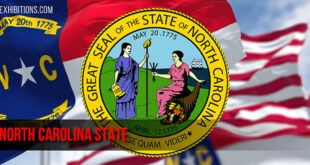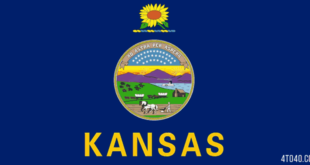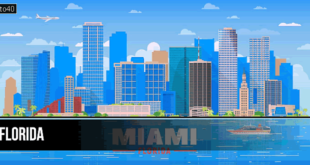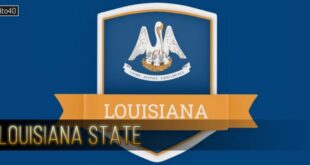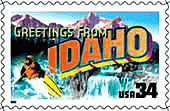 Idaho, a Pacific Northwest state, links the Great Plains and the Northwest coast. It is bounded on the north by British Columbia, on the east by Wyoming and Montana, and on the south by Utah and Nevada. Its western border with Oregon and Washington follows, in part, the course of the SNAKE RIVER. The ROCKY MOUNTAINS dominate the entire landscape except for the Snake River plain, which cuts across the southern part of the state. Idaho’s wealth of natural resources, along with its scenic attractions, forms the base of the state’s economy.
Idaho, a Pacific Northwest state, links the Great Plains and the Northwest coast. It is bounded on the north by British Columbia, on the east by Wyoming and Montana, and on the south by Utah and Nevada. Its western border with Oregon and Washington follows, in part, the course of the SNAKE RIVER. The ROCKY MOUNTAINS dominate the entire landscape except for the Snake River plain, which cuts across the southern part of the state. Idaho’s wealth of natural resources, along with its scenic attractions, forms the base of the state’s economy.
Land & Resources
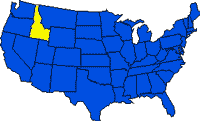 The broad, arid Snake River valley arcs across the southern part of Idaho. The plain developed when a series of high ridges to the north and south of the river began to sink and their intervening valleys became filled with lava and windblown soils. The valley of the Snake provides an access route from the Great Plains to the Pacific Northwest. Farther north, rugged mountains of the Bitterroot, Lost River, Pioneer, and Sawtooth ranges, separated by deep canyons and interrupted by occasional prairies, make up nearly all the rest of the state. Other than that portion of the GREAT BASIN rim in the southeast, all of Idaho is part of the COLUMBIA RIVER basin. Almost 64% of Idaho is owned by the U.S. government. Mountains or deserts used for forestry and grazing make up almost all these public lands.
The broad, arid Snake River valley arcs across the southern part of Idaho. The plain developed when a series of high ridges to the north and south of the river began to sink and their intervening valleys became filled with lava and windblown soils. The valley of the Snake provides an access route from the Great Plains to the Pacific Northwest. Farther north, rugged mountains of the Bitterroot, Lost River, Pioneer, and Sawtooth ranges, separated by deep canyons and interrupted by occasional prairies, make up nearly all the rest of the state. Other than that portion of the GREAT BASIN rim in the southeast, all of Idaho is part of the COLUMBIA RIVER basin. Almost 64% of Idaho is owned by the U.S. government. Mountains or deserts used for forestry and grazing make up almost all these public lands.
Rivers and Lakes
Except for the Bear River in southeastern Idaho and the Kootenai, Pend Oreille, and Spokane systems to the north, the Snake River drains virtually the entire state. The Big Wood, Blackfoot, Boise, Clearwater, Payette, and Salmon rivers flow into the Snake, along with many smaller rivers. More than 1,609 km (1,000 mi) long, this major river discharges more water than the Colorado and Sacramento rivers combined.
Idaho has four large lakes: Pend Oreille, Coeur d’Alene, Priest, and Bear. Thousands of small lakes and reservoirs contribute to the state’s expanse of inland water. Idaho contains four of the federally-administered wild rivers, segments of the Clearwater, Rapid, Salmon, and Snake.
Climate
Elevation and latitude influence the diverse climate found in Idaho. The Lewiston area, in the north, has the warmest climate, while higher cities in the southeast are much cooler. Northern canyons above Lewiston average 11 deg C (52 deg F) annually; the southwestern valleys in the Boise region, averaging 1 degree cooler, are comparable. The southeastern highlands, however, are substantially colder (6 deg C / 42 deg F).
Low humidity makes hot desert summers more tolerable; particularly at higher elevations, daily variation in summer temperatures often approaches 22 C degrees (40 F degrees). Precipitation ranges from 152 mm (6 in) or less in desert areas to 2,504 mm (99 in) in the mountains.
Vegetation and Animal Life
Coniferous forests cover about 40% of the state, while pasture and rangelands constitute almost one-half of the remainder. Much of Idaho’s grazing land is semiarid, and a substantial portion of the land used for farming requires irrigation.
Large indigenous animals include deer (white tail in the north, mule deer farther south), elk, moose, mountain goats, big horn sheep, antelope, cougars, and bears. A few grizzlies inhabit remote areas. A large variety of smaller animals typical of the mountain and desert west abound throughout the state. Wilderness-preservation efforts help to maintain the wildlife population.
Historic Sites
Three of Idaho’s specific historic interest are along the course of the LEWIS AND CLARK EXPEDITION. Others include Fort Hall near Pocatello, City of Rocks along the California Trail, and two important buildings–the Jesuit Coeur d’Alene Mission near Cataldo and the U.S. Assay office in Boise. Nez Perce National Historical Park has sites in northern Idaho.
Tourism
Although Idaho’s mountainous topography creates serious economic problems, recreation and tourism benefit from this natural heritage. Federal financial assistance has enabled Idaho to develop areas for tourism, such as Lava Hot Springs State Resort near Pocatello. Special attractions include the nation’s pioneer ski resort at Sun Valley, developed by the Union Pacific Railroad in 1936. Other attractions are the Nez Perce National Historical Park, CRATERS OF THE MOON NATIONAL MONUMENT, City of Rocks National Reserve, Hagerman Fossil Beds National Monument, and YELLOWSTONE NATIONAL PARK on the Wyoming border. Special events appealing to tourists–who spend hundreds of millions of dollars annually in Idaho–include rodeo and regional fairs.
History
Idaho has been inhabited for more than 14,000 years. A continental ice sheet extended into northern Idaho at the time of first habitation. As the ice receded, floods swept through northern valleys. The largest of these torrents–equal to ten times all the rivers of the world combined–occurred about 12,000 years ago when ancient Lake Missoula (see LAKE, GLACIAL) overflowed and washed out a 610-m-high (2,000-ft) ice dam. That catastrophe was followed by a hot, dry epoch, then another cold period. The early inhabitants hunted mammoths and other large animals now extinct. These early people migrated throughout the region.
By the 18th century, Idaho was the home of six Indian tribes: KUTENAI, Pend d’Oreille (or FLATHEAD), Coeur d’Alene, and NEZ PERCE in the north; and Northern SHOSHONI and Northern PAIUTE (known as Bannock) to the south.
Exploration and Fur Trade
After the Lewis and Clark Expedition discovered the Salmon and Clearwater country in 1805-06, fur trappers explored the rest of Idaho in search of beaver. Idaho’s Snake River area became a disputed borderland in which British and French trappers, based in Montreal and the lower Columbia River valley, competed with U.S. adventurers from Saint Louis. By 1840 trapping had almost ended, and the HUDSON’s BAY COMPANY gained control of the region. The United States acquired the southern part of the Oregon country, including all of present-day Idaho, in 1846. Hudson’s Bay Company, with posts at Fort Hall and Fort Boise, continued to serve the settlers traveling to the west over the OREGON TRAIL and California Trail. Permanent white settlement began in 1860, when Mormons moved northward from Utah and miners arrived from the Pacific coast.
Statehood
After territories were formed in Montana (1864) and Wyoming (1868), Idaho’s boundaries enclosed two areas divided by mountains. For a quarter-century, North Idaho tried without success to form a new territory with eastern Washington, or, as a last resort, rejoin Washington. The U.S. Congress voted in 1886-87 to annex North Idaho to Washington Territory, but President Grover Cleveland was persuaded not to approve that change.
Although Idaho Territory had been overwhelmingly Confederate Democratic after 1864, a coalition of Republicans and anti-Mormons gained power in 1882. By 1888, Idaho had become safely Republican. In attempting to establish control over the U.S. Congress, the Republicans voted for admission of the territory. Idaho was made a state on July 3, 1890.
Political and Economic Unrest
A silver-price collapse (1888-92), followed by a national economic panic, severely hurt Idaho. The Populist candidate James B. Weaver received the state’s votes in the presidential election of 1892, as did William Jennings BRYAN in 1896. Idaho thus expressed its discontent with the federal government’s economic policies. Labor battles in the Coeur d’Alene mine area attracted national attention in 1892 and 1899. Sheep ranchers and cattlemen, vying for the limited rangeland available, clashed during that same period. By 1900, Idaho began to avail itself of national legislative programs, enacted in 1894 and 1902, directed at large-scale reclamation projects.
The state developed rapidly in the early 1900s, spurred by the commercial lumber industry. National farm and forest products markets, along with large-scale mining, developed in all parts of the state, but in 1920, a severe agriculture price collapse, followed by the Depression of the 1930s, intensified the state’s problems; federal expenditures helped Idaho’s economic recovery. Important military bases (a large naval training station on Lake Pend d’Oreille; air bases at Boise, Pocatello, and Mountain Home; and a naval gun plant at Pocatello) contributed to the state’s economy after 1942. Idaho’s largest federal installation, a National Reactor Testing Station located west of Idaho Falls, superseded Idaho’s naval-gun testing area in 1949, developing nuclear power there 2 years later.
Contemporary Idaho
Issues related to maintenance of a high-quality environment and to wilderness preservation in vast mountain areas of the state have remained prominent in recent decades. With extensive wilderness, and with constantly increasing pressures of economic and population growth, Idaho serves as an example for the study of contemporary environmental problems.
Land
- Area: 216,456 sq km (83,574 sq mi); rank: 13th.
- Capital and largest city: Boise (1990 pop., 125,738).
- Counties: 44.
- Elevations: Highest–3,859 m (12,662 ft), at Borah Peak; lowest–216 m (710 ft), at the Snake River, Lewiston.
 Kids Portal For Parents India Kids Network
Kids Portal For Parents India Kids Network




